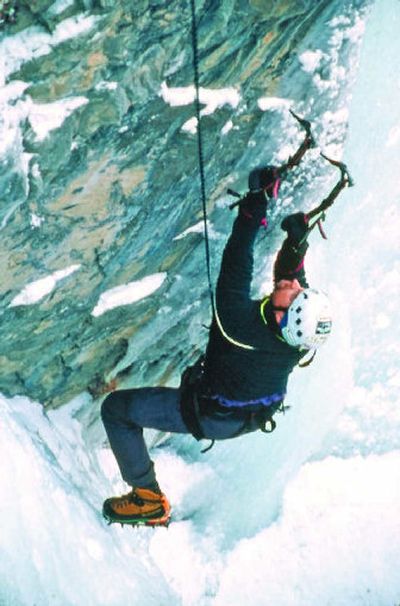Conquering frozen fortresses

To even the most hardened, risk-taking athlete, the idea of hanging from an icy perch 150 feet above the frozen ground sounds like an exercise in insanity.
For climbers Rich Bennett and Jason Baker, however, it’s just another day of fun and adventure.
“A lot of people think we’re crazy. They think ice climbing is crazy,” said Bennett, 46, of Hayden Lake. “In fact, what we do is risk management. Every move is deliberate. Every route is well-planned.”
“It’s not a ‘drop the clutch and go’ kind of sport,” added his six-year climbing partner, 37-year-old Baker, of Hayden.
The two outdoor adventurers are a couple of the most accomplished ice climbers in the Inland Northwest, with a combined 26 years of ice and alpine climbing under their harnesses.
Though they participate in different aspects of rock climbing during the warmer months as training, they agree that ice climbing requires a skill set even the most seasoned rock stars have a hard time with.
In fact, they lead an annual ice-climbing seminar in Canmore, Alberta, for the Spokane Mountaineers, a locally based group of outdoors enthusiasts who revel in trekking to the farthest reaches of the wilderness.
“We’re lucky here in the Spokane area. Within six hours in any direction, we have world-class ice climbing that people travel from around the globe to get to. The climbing in Canada is world class, and there are some great local spots, too,” Bennett said.
In order to scale the slippery faces, ice climbers must invest about $2,000 in gear, including hollow bolts that are threaded into the ice as the first climber scales the wall, or leads. Crampons, which are sharp metal spikes, are attached to the boots of the climber. Crampons pierce the ice more than an inch with each step, and the climber uses myriad other handheld axes and picks in order to safely grapple to the top of a pitch.
Though ropes and several forms of anchoring systems securely tether climbers, Bennett and Baker agreed that the most dangerous part of winter climbing is the possiblity that those systems could fail and a climber would fall.
“In summer, it’s no big deal,” Bennett said, referring to climbing rocks rather than ice. “Guys will fall; the rope will catch them and just try the line again. The rope still catches us, but we have the crampons on and if they catch our clothes or the ice as we’re falling, it can snap a leg like a twig.”
Baker added, “And with all the sharp tools that we’re carrying with us, if we land on them, that’s it.”
Over the years, the pair has managed to avoid severe accidents or incidents, but there have been some close calls.
“Every climber has an epic,” Bennett said, recalling one particular route the pair got a late start at last year. “The goal is always to be down the pitch by dark, but that day, it took a little longer to lead than I thought, and it was dark by the time Jason got to the top.” That made for one miserable final push and descent, he said.
On that very same excursion, Baker recalls another of the sport’s many risks hitting him – in the helmet.
“As Rich was doing that lead, a piece of ice broke off and hit me square in the head.” He demonstrated the shoebox-sized chunk of frozen water with his hands. “I felt that one!”
In spite of the danger, and sometimes because of it, they never have any trouble finding inspiration or motivation to keep heading out into the cold winter and climbing the impossible.
“An entire route can change within an hour. Usually, the route you climb will have completely changed by the time your partner climbs it,” Bennett said, “and over the course of a route, the ice itself may change from hard as a rock to more plasticky or wet and slippery. There are so many variables.”
In order to train for a planned 2008 excursion up Denali, the 20,320-foot south peak of Alaska’s Mount McKinley, the two have started ramping up their skills and fitness over the past few months by testing their mettle on some of the West’s greatest climbs. Two such climbs were their treks up Liberty Ridge on Mount Rainier and the North Face route up Mount Athabasca in the Canadian Rockies. These are considered classics in the climbing community and are among the most challenging around. The routes also have proved deadly on more than one occasion, so risks are always calculated, and failure is not an option.
“There are times where, before I make a move, I’ll think of my family and what’s waiting for me at home before I commit,” Bennett said. “It helps you analyze the risk and evaluate before you do it, and it keeps me safe.”
Safe. Tethered to a giant ice sheet, carrying sharp tools while holding yourself 1,500 feet in the air. Right. Safe is a good word for it.